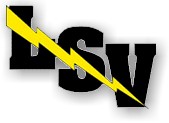
Your Professional Lightning Protection Installers
| About LSV |
| You are guaranteed to receive the most effective lightning protection available. |
| What is a Lightning Protection System? |
| A lightning protection system is a passive means of preventing property damage from the effects of a lightning strike. |
| Who Needs Lightning Protection? |
| If your home or business meets 5 or more of the following criteria, you are in a high risk group. |
| Personal Lightning Safety |
| If you are outside and you notice a storm brewing, do you know what to do? |
| Lightning Protection Specifications |
| All lightning protection materials and components shall comply in weight, size and composition with UL96A and NFPA-780 lightning protection material code requirements for this type of structure. |
| Contact Us |
| Questions or Comments? We'd love to hear from you. |
What is a Lightning Protection System?
A lightning protection system is a passive means of preventing property damage from the effects of a lightning strike. It works by providing the electric charge produced by the clouds a path of least resistance to the ground. There are four main parts of a properly installed lightning protection system: copper air terminals, copper cable, copper clad ground rods, surge suppressors.
The air
terminals and cable are typically copper, but sometimes they can (or must)
be aluminum.  All
of the air terminals are connected via the cable which has a minimum of
two ground rods buried 10 feet below grade. This system is then grounded
to both the water pipes and existing ground of the circuit box. The surge
suppressor can be connected to the breaker box to cover the entire electric
system or they can be placed at individual appliances or electronics.
All
of the air terminals are connected via the cable which has a minimum of
two ground rods buried 10 feet below grade. This system is then grounded
to both the water pipes and existing ground of the circuit box. The surge
suppressor can be connected to the breaker box to cover the entire electric
system or they can be placed at individual appliances or electronics.
When most people hear the term lightning rod, they picture large ornate rods with heavy cable draped on the roof and down the sides of old homes (see fig. 1). LSV tries to make the lightning protection system as inconspicuous as possible.
Typically, the only things visible on a lightning protection system are the air terminals, 10"-12" copper rods, on the chimney and roof ridges. If the system is to be installed on an existing building, every effort is made to conceal the copper cable (see fig. 2).
 If
the copper cable cannot be concealed, the cable will be less noticeable
as it weathers and changes from shiny orange to dull patina (see fig.3).
Whether a lightning protection system is concealed during construction
of a new building or exposed on an existing structure, the materials used
are identical.
If
the copper cable cannot be concealed, the cable will be less noticeable
as it weathers and changes from shiny orange to dull patina (see fig.3).
Whether a lightning protection system is concealed during construction
of a new building or exposed on an existing structure, the materials used
are identical.
Lightning
protection systems can be installed on a variety of structures including
homes, businesses, farm buildings, boats, and trees to protect them from
damage.  There
are several independent organizations that have issued standards on the
installation and design of lightning protection systems. The three most
recognized are Underwriters Laboratory (UL), Lightning Protection Institute
(LPI), and National Fire Protection Association (NFPA). Fore more detailed
information on the standards you can contact any of the organizations
and ask for a copy of UL96A, LPI-175, or NFPA-780, respectively.
There
are several independent organizations that have issued standards on the
installation and design of lightning protection systems. The three most
recognized are Underwriters Laboratory (UL), Lightning Protection Institute
(LPI), and National Fire Protection Association (NFPA). Fore more detailed
information on the standards you can contact any of the organizations
and ask for a copy of UL96A, LPI-175, or NFPA-780, respectively.
Home | About LSV | Lightning Protection | Who Needs It? | Personal Safety | Specs | Contact
Lightning Systems
of Virginia LLC, P.O. Box 8985, Richmond, VA 23225
(804)-230-9169 Fax: (804)-230-1588 sales@lightningsystemsofva.com
© 2007 Lightning Systems of Virginia, LLC.
All rights reserved worldwide. E-mail webmaster.